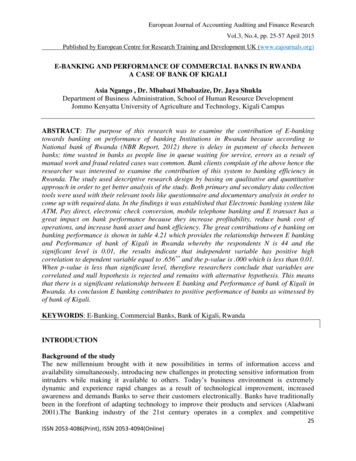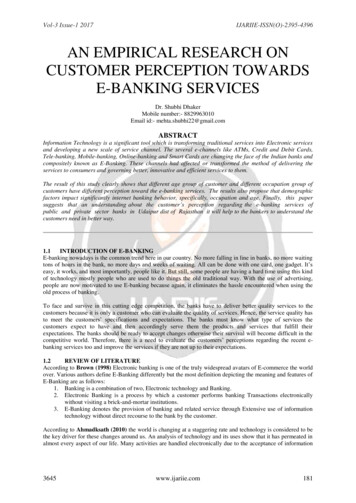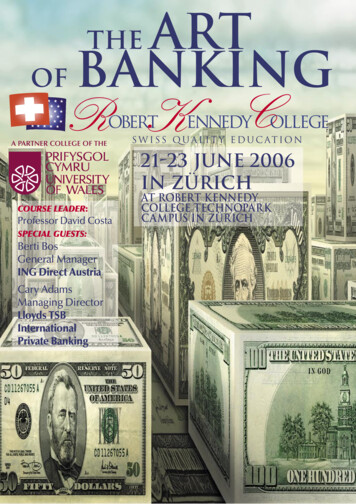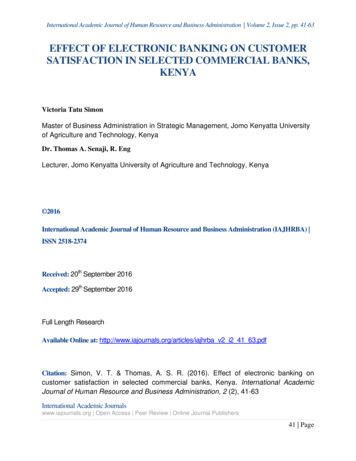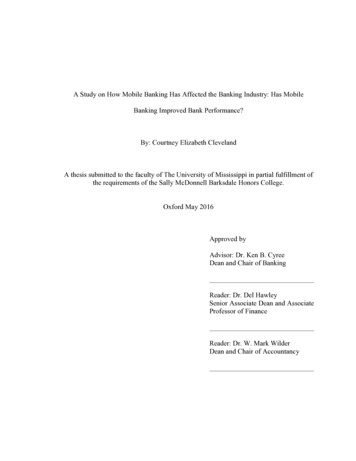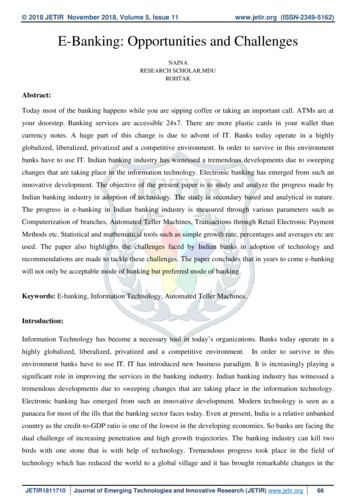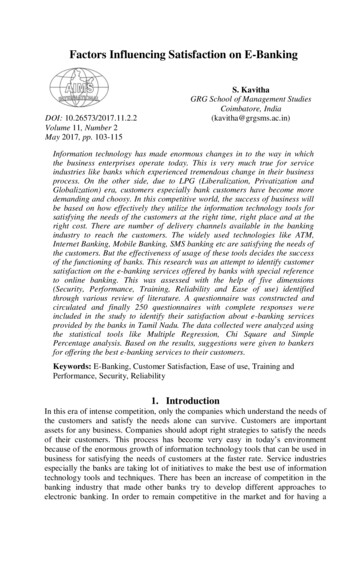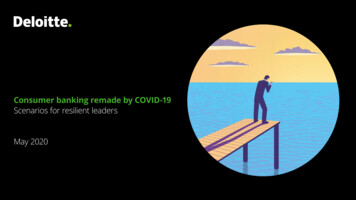
Transcription
Consumer banking remade by COVID-19Scenarios for resilient leadersMay 20201 as of April 2020
In the wake of COVID-19, Deloitte and Salesforce hosted adialogue among some of the world’s best-known scenariothinkers to consider the societal and business impact of thepandemic. The results of this collaboration can be found inThe world remade: Scenarios for resilient leaders.2
Banks have become a cornerstone in thebattle against COVID-19 as they continueto provide essential services to maintainthe economy throughout the pandemicThis document intends to provide consumer banking leaders potentiallong-term implications of COVID-19 for the consumer banking sector3
1 / An industry remade2 / Making sense of the future3 / A closer look at the scenarios4 / Team and acknowledgements4
An industry remadeWe are in uncharted waters; yet, bankingleaders should take decisive action to helpensure their organizations are resilientHow might consumerbanking evolve in thecoming years, andhow can leaders beprepared?Deloitte’s Resilient Leadership framework defines three time frames of the crisisRESPONDRECOVERTHRIVEManage continuityLearn and emerge strongerPrepare for the next normalFocus of this document: Scenarios for resilientleaders with a medium-term viewRefer to Thrive scenarios for resilient leadersfor a long-term viewThis document introduces scenarios of how the US consumer banking landscape may develop over the nextone to three years and is intended to help leaders explore some of the potential medium-term implicationsof COVID-19. These scenarios outline potential futures, created to spark insight and spot opportunity.Because, as Peter Drucker famously observed, “the greatestdanger in times of turbulence is not turbulence itself, but to actwith yesterday’s logic.” 151Managing in Turbulent Times by Peter F. Drucker (1980)1.Explore how uncertaintiesduring the pandemic couldshape US consumer banking inthe medium term2.Have productive conversationson the lasting implications andimpacts of the crisis3.Identify decisions and actionsthat will improve US banks’resilience to the rapidly changinglandscape4.Move beyond “responding”to the crisis and toward“recovering” in the medium term
An industry remadeScenario thinking can help us better informour decisions in an uncertain futureThis document explores various scenarios about howthe COVID-19 pandemic could accelerate or redirectthe consumer banking industry over the next oneto three years. Building on several trends already inmotion, the scenarios are built on important macroand banking sector uncertainties, both alreadyevident and others potentially plausible based on theseverity of the pandemic and government actions.These scenarios target consumer banks, which inmany cases includes retail and small- and mediumsized businesses (SMBs).We chose to focus on the next one to three years onthe assumption that this time frame is long enoughthat change is possible, but close enough that itmatters to executives today.6As you read this document, challenge yourself toimagine how things you were sure to happen couldnow be on a different course. Avoid the temptation toconclude that the crisis will accelerate the changes youalready expected or believed were inevitable or that thescenarios are truths or future forecasts.This document and its depiction of possible futurescenarios should ultimately spark several questionsaround implications and next steps for your organization.What are scenarios?Scenarios are stories about whatthe future may be like, createdthrough a structured processto stretch thinking, challengeconventional wisdom, and drivebetter decisions today. They are notpredictions about what will happen.They are hypotheses about whatcould happen, designed to openour eyes to new opportunities orhidden risks.Note that these scenarios stand as of theend of April 2020. They are based on ourbest understanding of the health trajectory,economic impacts, and government actionsin response to the COVID-19 pandemic.
1 / An industry remade2 / Making sense of the future3 / A closer look at the scenarios4 / Team and acknowledgements7
Making sense of the futureTwo critical uncertainties will drive the overall impact of COVID-19128What is the overall severity of the pandemic and pattern of disease progression?Lower impactHigher impactRapid peakSelf-dampeningGradual progressionRoller-coasterSecond-actThe virus’s spreadshows a rapid peakbefore quickly decliningRapid exposure acrossindividuals leads toeventual “herd immunity”A gradual and prolongeddevelopment of thevirus’s spread is seenSeasonal waves of theviral disease are seen, withdecreasing degrees of severityA second wave of viralinfections emergesstronger than the firstWhat is the level of collaboration within and between countries?SignificantMarginalCoordinated responseWeak and divided Nations “think big and act fast.” Effective collaboration within and betweencountries to contain the virus’s spread through coordinated strategies andbest practices (such as mandating quarantines and testing) Lack of coordination among governments and institutions to providesupplies and resources required to prevent virus’s spread Lack of accountability and breakdown in communications and information-sharing Coordination to reduce mobility of people and slow transmission Proactive measures by public institutions to prevent future widespread virusesInsufficient and uneven response to effectively address mobility of people carryingthe diseaseNote: Refer to “The world remade by COVID-19: Scenarios for resilient leaders,” section 2
Making sense of the futureThe passing stormLone wolvesMarginalFour scenarios as thought startersLone wolves Relatively constrained disease dynamic Effective health system and policy responseProlonged pandemic period, spurring governments toadopt isolationist policies, shorten supply chains,and increase surveillance. Severe, rolling pandemics Insufficient global coordination and weak policyresponseGood companySunrise in the eastLevel of collaborationwithin and among countriesThe pandemic is managed due to effectiveresponses from governments to contain the virus,but is not without lasting repercussions, whichdisproportionately affect SMBs and lower- andmiddle-income individuals and communities.Good companySunrise in the east More prolonged pandemic Collaboration to control the pandemic led by largecompaniesChina and other East Asian nations are moreeffective in managing the virus and take the reins asprimary powers on the world stage. Severe pandemic Collaborative health response led by East AsiancountriesSignificantGovernments around the world struggle to handlethe crisis alone, with large companies stepping upas a key part of the solution and an acceleration oftrends toward “stakeholder capitalism.”The passing stormLower impact9Severity of pandemicHigher impactNote: Refer to “The world remade by COVID-19: Scenarios for resilient leaders,” section 2
Making sense of the futureThese scenarios illustrate potential ways in which the USconsumer banking landscape could unfold over the medium term10The passing stormGood companySunrise in the eastLone wolvesThe US economy recovers rapidly after an initialrecession due to an effective healthresponse from the federal andstate governments recovers more slowly, relying onlarge corporations to lead the recoveryas the government struggles recovers very slowly due to theprolonged nature of the virus, with foreigninvestments helping the economy torecover is left in turmoil as global supply chainsare disruptedConsumerbehaviors return to status quo with no materiallong-term changes in behaviors orattitudes become more comfortable sharingdata with corporations as trust in theseincrease become less loyal and moreaggressively search for offers andpersonalized customer experiences demand that most interactions arecontactless and continuously search foryield across banking offersBanking industry reverts to pre-crisis levels, althoughweaker banks struggle during the crisis becomes more crowded as nonbanksenter via banking-as-a-service transforms as platforms gain inpopularity and foreign players and banksexplore alliances/M&A shrinks dramatically due toprolonged crisis; many banks struggleto navigate poor long-term creditperformanceRegulation converges to global standards asgovernments find common cause tocollaborate (e.g., open banking) eases and champions both ease ofbusiness for banks and collaboration accommodates greater foreigninvestment and roles for internationalplayers supports protectionist policies,with stricter regulation limiting foreigncompetitorsTechnologyadvances stay on course, but with a greater focuson modernizing legacy systems focus on “more human” digitaladvice and personalization ascustomers offer up more data shift to support platform modelsunderpinned by public cloud and sharingcosts through utilities focus on contactless solutions asrolling pandemics threaten in-persontransactionsProfit margins are initially squeezed; however, theCARES Act helps banks to gain from feesfrom the stimulus package and supportthe economy are challenged by the prolonged crisisbut recover due to lower price sensitivity never recover for banks, who struggleto own customer experiences and do notdevelop new differentiators are challenged by low rates and poorcredit performance, but eventually recoverdue to market consolidation and priceincreases
Making sense of the future10 potential implications for consumer banking in the US,irrespective of which scenario unfolds11Laser focus oncost-to-serveFinancial institutions’ profits will be under pressure due to potentialincrease in credit losses and a low-interest-rate environmentPreservehumanconnectionDespite banks placing more control directly into customers’ hands viaself-service, human interaction via call centers and branches will remaincritical, with contact centers notably rising in importanceDigitalaccelerationDigital agility will accelerate in importance, requiring banks to restructuretech (e.g., cloud) to reduce costs and improve agility. Regulators mightrespond with mandated investments in digitizing the core and revisedstress testing scenarios, leading to capital and investment constraintsStick toremote workRemote-working models could remain as the new normal for manyfunctions, especially the middle and back office (increasing operationalrisk and need for focus on operational resiliency). Human and machinecollaboration will progress, creating broad need for retrainingAdvanceno-touchexperienceContactless payment products, artificial assistants, and their supportingcapabilities (e.g., cybersecurity) will see greater demand and investment;and digital experiences will become more humanNon-FIs enterNon-FIs (e.g., retail, big tech) will accelerate their entry into consumerbanking and pressure incumbents and take the innovation initiative.There is significant M&A potential within the fintech sectorBeware of highrisk of switchingFirms who make mistakes and are unresponsive to customers maylose loyalty during a period where customers are more sensitive topoor experiencesAcceleratebranchmakeoversOverall branch transformation efforts will be accelerated through newconcepts, further footprint consolidation, more standalone ATMs withadditional servicing capabilities where branches once were, and reorganization of existing full-service branches to specialized advice centersMake or breakfor challengersReliance on contactless channels and more yield-seeking behaviorby customers provide a perfect opportunity for challenger banks tocapitalize, provided they can navigate the credit cycleGrowth shiftaway fromtier 1 citiesPopulation growth will accelerate the shift away from tier 1 cities (e.g.,New York, Los Angeles) and toward their suburbs. Further growthwill shift toward tier 2 cities (e.g., Charlotte, Orlando)
Making sense of the futureActions to avoidNo-regret actionsSeven no-regret actions for the following six to nine months thatcan better position banks to recover121. Take lead to support communitiesShow empathy to customers, as in the short run it will drive long-term differentiation. Banks should respond with community investment funds and othercommunity-building efforts. Also, determine a sensible collections strategy that supports customers and communities while maintaining solid books2. Accelerate time-to-market in front officeContactless channels (e.g., digital, call center) will accelerate in importance and become a source of differentiation. Prioritize the initiatives that will accelerate theability to quickly deliver needed features and functionality, i.e., accelerate modernization and digital innovation efforts3. Help customers outlast the crisisAddress customers’ financial needs without exposing bank’s viability (e.g., communicate, proactively reach out, update product pricing, change policies on loanforbearance, develop tailored plans to catch up for repayments, and support SMBs with capital solutions)4. Proactively review and manage credit portfolioProactively review credit product portfolios to identify industries and customers at risk of default. Start developing new scorecards and forecast models toidentify customers at risk of default based on specific information (i.e., impact analysis by industry) and actively communicate with customers5. Focus efforts on mid-term profitability opportunitiesPrioritize branch strategy refinement; configure flexible working models (e.g., remote work options); increase investment and speed of bringing to market newtechnology, determine impact on cross-sell as potential long-term impact of ability to sell via physical channels6. Accelerate modernization and digital(i.e., public cloud and AI)Prioritize loan processing for existing customers; then focus on medium-term initiatives to modernize technology infrastructures that support changing risk andcost positions, and provide a foundation for next gen digital channels7. Redefine call center strategiesRedefine call center strategy and upscale in capabilities as call centers have increased in relevance. Use the opportunity to include intelligent automation. Shift toremote working models to improve service and cost efficiencyDon’t shift from product innovation to customer serviceAlthough it is critical to focus efforts on customer service, product innovation should remain central to address customers’ financial needs as a result ofCOVID-19, ensuring not only customers remain loyal to the bank, but also to potentially increase market shareDon’t make wholesale changes to processesUpdating and refining risk processes is imperative; however, massive changes of processes in the short term may be risky. Process changes may affectoperations efficiency and the capacity to respond against customer demands or market changesDon’t make wholesale changes to your hiring strategy andperformance managementFor the short term, and until uncertainties in the market become more clear, hiring strategy and performance management should remain the same to avoidcreating an organizational structure that is out of line with what the market and customers requireDon’t rush for an expansion, but carefully determineinvestmentsAs success factors for expansions are unclear, careful decision-making is required; ongoing expansion plans may continue to be executed. New plans should bereconsidered until the market shows more clarity around how the consumer banking industry may evolve
1 / An industry remade2 / Making sense of the future3 / A closer look at the scenarios4 / Team and acknowledgements13
As you reflect onthese scenarios forconsumer banks,consider A closer look at the scenariosHow to read the following pagesAs you read the scenarios,DO focus on why this scenario might happen and what it would it mean ifit did.Structure of the following pagesPage 1 of 2: Overview resist the temptation to focus or anchor on the scenario closest toyour current expectations.DON’T Signals signposts depict theconditions that must be true forthe scenario to occurThe contextualenvironment paintsa picture of how eachparticular scenariounfoldsThe banking systemprovides a detailedanalysis of how thescenario unfolds withinthe consumer bankingindustry focus too much on specific details. Instead, read for the overalldirection and conditions each scenario creates. expect to see specific forecasts or detailed views on specific banksaccording to their characteristics or type (e.g., size in the market,capabilities, regional vs. global bank). try and assign probabilities to these scenarios. At this moment, thequestion should be, what do we need to be ready for, even if we thinkit’s “improbable?”14How are your businesses impactedin these scenarios? What would haveto change if one of these scenarios remember that there is no data about the future. There is only dataabout the past. These are efforts to spark new ideas about the future.If they don’t challenge your expectations, they’re not doing their job.As you read the scenarios, were to unfold? What opportunities that seemedunattractive pre-COVID could beattractive now? What might consumers value inparticular in these different worlds?How might that vary by geography,customer segment or products? What are the biggest threats to yourcurrent business in these worlds?Page 2 of 2: A closer look What new providers, companies,business models, and ecosystemsAdditional narrativeelements depictimplications toecosystem participantsand the competitiveenvironmentmight emerge? Which existing companies are bestpositioned to succeed? What capabilities, relationships, andassets are important in these worlds?
Scenario 1The passing stormContextual environment The COVID-19 pandemic shakes America, but after a slow initial reaction, the pandemic ismet with an increasingly effective health system and a strong political response. The virusis eradicated earlier than feared due to coordinated measures by global players to spreadawareness and share best practices Economic growth takes a hit in the immediate aftermath of the crisis, but the CARES Act andadditional government relief limits the shock and bolsters consumer confidence, returning theeconomy to positive growth in 2021 Although short-lived, the pandemic exacerbates the challenges of socioeconomic inequality, aspeople’s uneven ability to weather the storm becomes highly evident In response to short-lived quarantine measures, development in communications andcollaboration tools sees massive acceleration, particularly in remote conferencing and VRBanking systemSignals signposts: Strong policy response prevents structural damage to the banking industry and leads activityto recover to positive growth within one to two years Most mid-tier and community banks weather the storm due to both their strong capitalreserves and effective government actions (including the CARES Act) designed specifically tosupport them Governments effectively collaborate to share best practicesand resources No indications of a second wave of the virus Challenger banks and noncharter financial institutions are shaken due to their lack of liquidityand capital access, driving regulators to further scrutinize these players Mechanisms to combat the virus (e.g., immunization) are mobilized Market consolidation continues and accelerates slightly above the pre-crisis rate Economic activity rebounds in late 2020. Recovery initially slow,but speeds up in the second half of 2021 as consumers becomemore confident Increased collaboration between countries leads to further convergence of global bankingregulations around open banking and data sharing, placing more control into the handsof customers15
A closer look at the scenariosThe passing cts Low-income consumers and SMBs are hardest-hit, as theyare primarily employed in the most impacted industries;however, government stimulus and economic recovery helpto limit the shock Crisis exposes the fragility of human services channels (callcenters and branches), which struggle with high volumeduring and after the crisis, resulting in significant customerdissatisfaction Margins recover slowly to pre-crisis levels due to therenewed low-rate environment, but pricing structures donot shift materially in the long term Despite being more accustomed to digital channels fortransactional services, customers still rely on branches tosatisfy complex needs (e.g., financial advice for mortgageloan) Channel investments shift marginally to self-service (e.g.,mobile, online) and call centers Branch transformation efforts are unchanged, but become amain priority for incumbents as they seek to rationalize, offerstand-alone ATMs, develop companion branch models, andbegin to develop significant AI use cases for branchesNumber of secondary deposit accounts grow as customersfrustrated with poor experiences through the crisis usedigital account opening functionality to open secondaccounts—customers do not shift the majority of balancesto new accounts Volume of auto loans, student loans, and mortgage loansquickly recover to pre-crisis levels as home ownership andeducation become staples of the recovery Ecosystemparticipantimplications16Consumers gain trust in banking institutions, as banks areseen to largely weather the stormIncumbentsNew entrants Incumbent banks’ resiliency through the crisis leads to an increase in customers’ trust and loyalty Despite lagging technology investments to meet customers’ expectations, government support andcustomer loyalty help regional and community banks to remain competitive in market and continue on theirpre-crisis trajectoryChallenger banks struggle with little government support and poor economics, butmaintain their focus on the pre-crisis strategy, increasing market share throughserving niche segments Retailers and tech firms find their increased share of online and foot traffic sticky,leading to more interest in offering consumer banking services through partnershipwith banks Some mid-tier financial institutions face less profitable margins, becoming acquisition targets for scaleplayers to increase the size of their books
Scenario 2Good companyContextual environment The pandemic persists past initial projections, placing a growing burden on global governmentswho struggle to handle the crisis Financial institutions and other large corporations step up to fill the void left by theuncoordinated response among global governments, gaining trust and prestige US economic recovery starts slow in early 2022 and speeds up by the second half of the year.Interest rates stay near zero through the end of 2022 Large companies respond quickly and figure out how to configure and restructure their supplychains, observing a rapid growth in output after the crisisBanking systemSignals signposts: Demand for nonloan banking services recovers slowly and trust in banking institutionsincreases; leads to higher demand post-crisis and engages less price-sensitive customers Regulators loosen regulations to support flow of credit to the communities. Regulators aresupportive of big tech, challenger banks, and other new entrants who heavily use technologyand have low cost structures Increased trust in “good companies” results in customers willing to share data more broadly,which gives players who are able to drive insights and value an advantage over competitors Challenger banks and other niche players lean in and benefit from the rising tide of trust forinstitutions. Rising trust levels provide increased access to data, which further drives and setsthe pace of innovation Prolonged pandemic and economic downturn lead to a fundamental shift in the balance ofmarket power as M&A activity, from nontraditional players, impacts existing market structuresBanks and other businesses take initiative to combat the virus spreadand support recovery A shift towards greater corporate responsibility is seen with new longterm outlooks, leading to greater emphasis on investing in workers andcommunities Economic recovery begins late 2021. Recovery slows in early 2022 andspeeds up by the second half of 202217
A closer look at the scenariosGood ducts Prolonged crisis results in increased demand, adoption, andusage of digital channels, leveraging AI to create conversationaland more “human-like” interactions Banks use customer data to develop personalized andtailored products and services But advice still continues to be largely human-based (e.g.,trading, wealth, and mortgage)Advice and speed to credit are among the most criticalcompetencies developed by good companies Branch transformation is accelerated, migrating from a fullservice channel that processes transactions, to a relationshipmanagement channel focused on advice for consumers—enabled by stand-alone ATMs and strong support tools (e.g., AI)Financial institutions develop innovative and targetedsolutions for underbanked individuals, covering basicfinancial needs at an achievable cost Ecosystemparticipantimplications18Trust skyrockets for banks and corporations whodemonstrated community support—leading to greaterloyalty, lower price sensitivity, and a greater willingness toshare dataAs banks have greater access to consumer data, individualsand SMBs are provided more relevant advice andproducts—extending a private banking-like experiencedown-marketPreviously unbanked Americans increasingly establish bankaccounts as trust improves and banks respond with tailoredsolutions (e.g., offering greater access and transparency)IncumbentsNew entrants A lower-for-longer-than-expected interest rate environment leads incumbents to identify new businessmodels that balance support for communities with sustainable profitability, improving trust and loyalty fromconsumers Big tech firms become critical sources of data as customers demand greaterpersonalization; these firms penetrate the market both single-handedly and throughpartnerships with banks and challengers Incumbents seize the opportunity to embed crisis-driven demand and processes into their long-termoperating models (e.g., significant improvement of seamless digital channels and agile working) Big tech firms use their customer service expertise to increase market share whilepenetrating the consumer banking industry Incumbents slow to implement new ways of differentiating face declining margins, as traditionaldifferentiators such as price and speed give way to new factors like personalization and ecosystems New entrants consider M&A of small- and medium-sized banks for increased speedto market Aggressive competition leads to further consolidation, notably among attractive mid-size players Incumbents aggressively reduce technical debt to achieve long-term operations efficiencyChallenger banks have the opportunity to provide products and services tounderserved segments, while large banks battle big retail and tech companies for theirexisting customers’ portfolio base
Scenario 3Sunrise in the eastContextual environment China and other Far East nations managed the disease earlier than Western nations andemerge from the pandemic stronger, while the Western nations struggle with deep and lastinghuman, social, and economic impacts. Economic power shifts east as Eastern countries helpthe world recover China and other Far East nations rapidly mitigate the pandemic within their borders and supportfriendly nations with resources and best practices. Mitigation efforts result in a shift of tradeflows away from the United States, reducing Far East dependency on US trade The US economy takes significantly longer to return to pre-COVID levels, resulting in a weakeningof the US dollar against the Yuan. Significant shrinkage is seen in the economy, and multiplelarge government bailouts are needed to keep major industries afloat. Pandemic creates a“social leveling” across all classes Increases in consumer data sharing with governments and businesses drive a leap forward in AIdevelopment, and the capability is quickly embedded into everyday life (e.g., health and security) Citizens accept government and institutional surveillance mechanisms as part of the public goodBanking systemSignals signposts: Far East nations emerge from the recovery period with lesseconomic impact Economic recovery begins late 2021. Recovery speeds up by the secondhalf of 2022, with quicker speeds of recovery in the East19Slow recovery and long-term near-zero interest rates result in muted balance sheets and a smallerbanking profit pool, driving increased market consolidation particularly among small- and midsized banks US banking policy shifts towards less protectionism and greater convergence with internationalrules (e.g., open banking), as better economic conditions abroad lead to a decline in investmentcapital in the US and a greater desire for foreign investment The largest East Asian banking and technology ecosystem players begin to make plans topenetrate the US markets Customers, hurt by the crisis, increasingly seek to optimize their financial situation as they searchfor yield. Platform models gain in popularity, offering institution- and product-agnostic algorithmsthat match customers with products based on price and fit (identified with data-driven insights) Incumbents accelerate their push for customers to be self-serviced through digital and call-centerchannels. The acceleration is driven by worsening customer economics and foreign new entrantsChina and other Far East nations significantly ramp up foreign directinvestment efforts, bolstering their global reputations
A closer look at the scenariosSunrise in the lications20CustomersChannelsProducts Customers, hurt by the crisis, increasingly seek to optimizetheir financial situation, leverage banking platforms tosearch for incr
Contactless channels (e.g., digital, call center) will accelerate in importance and become a source of differentiation. Prioritize the initiatives that will accelerate the ability to quickly deliver needed features and functionality, i.e., accelerate modernization and digital innovation efforts 3. Help customers outlast the crisis
